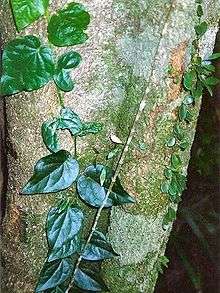Piper novae-hollandiae
Piper novae-hollandiae known as the giant pepper vine is a common climber growing in rainforests of eastern Australia. It is related to the pepper plant. It grows north from Mount Dromedary in southern New South Wales to tropical Queensland.
| Giant pepper vine | |
|---|---|
 | |
| Giant pepper vine on a black apple tree near Foxground, Australia | |
| Scientific classification | |
| Kingdom: | Plantae |
| Clade: | Tracheophytes |
| Clade: | Angiosperms |
| Clade: | Magnoliids |
| Order: | Piperales |
| Family: | Piperaceae |
| Genus: | Piper |
| Species: | P. novae-hollandiae |
| Binomial name | |
| Piper novae-hollandiae | |
First described by Dutch botanist Friedrich Anton Wilhelm Miquel in 1866, its specific name pertains to its location in New Holland (Australia).[1]
The giant pepper vine is a vigorous and rapid-growing climbing plant with stems which become woody and covered in rough, grey bark.[1] At its greatest development, the woody vine stem can be 40 cm (16 in) thick at the base, and may reach 30–40 metres in length.[2] Curtains of its leaves may sometimes be seen suspended from large rainforest trees. When the in the juvenile stage, its leaves are thin and ovate, measuring roughly 8 cm by 8 cm). Also ovate, mature leaves — referred to as "sun leaves" — are thicker and larger. They are a deep green color with visible veins, and measure approximately 12 cm by 8 cm.[1]
The small, cream-colored flowers of the giant pepper vine occur from April to August. Male flowers are arranged on a cylindrical spike, while female ones are on a more ovular one — both male and female flowers occur on a single given plant. Flowering is followed by a 0.5 cm, oval-shaped, red, fleshy drupe,[1] which provides food to rainforest wildlife.
Uses
The giant pepper vine is generally ornamental when cultivated, and grows too rapidly and to too great a volume for the average home garden, but has been used in larger parks and gardens, and as an indoor plant.[1]
References
- Elliot, Rodger W.; Jones, David L.; Blake, Trevor (1997). Encyclopaedia of Australian Plants Suitable for Cultivation: Vol. 7. Port Melbourne: Lothian Press. p. 331. ISBN 0-85091-634-8.
- Fairley A, Moore P (2000). Native Plants of the Sydney District:An Identification Guide (2nd ed.). Kenthurst, NSW: Kangaroo Press. p. 57. ISBN 0-7318-1031-7.
External links
- "Piper novae-hollandiae". Australian Plant Name Index (APNI), IBIS database. Centre for Plant Biodiversity Research, Australian Government.